Norman
Allan | ||||
|
REFLEXOLOGY speculations on a possible mechanism
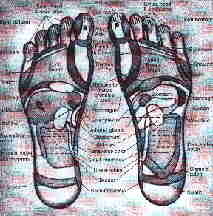 (an enlarged chart and link to source) Several healing systems claim that the body is mapped on its subparts. The archetype of these is Reflexology which finds the body mapped on the feet and on the hands, and claims that by massaging the feet and hands in appropriate places you can have effects on remote organs. Iridology maps the body on the iris and uses this map for diagnosis. 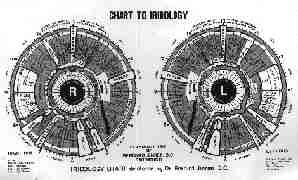
In the 1950s the French physiologist, Nogier, found a map of the body on the ears and used this "somatotopic" map both diagnostically and therapeutically. 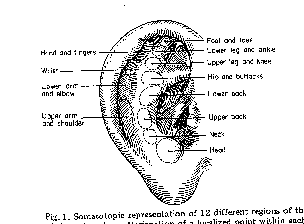
The Chinese have incorporated Nogier auricular system into Traditional Chinese Medicine as "auricular acupuncture". 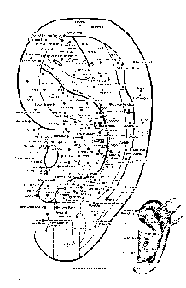
At first glance one might think the idea of these maps to be fantastic, but on further consideration the phenomenon is really something we might even expect. Somatotopic mapping is a fundamental activity of the central nervous system (CNS). The body is mapped on the brain again and again. For example, sensory nerves project (by way of intermediaries) to the "primary sensory cortex" which "maps" the body (SmI in the illustration), while the "map" in the primary motor cortex (MsI) projects to the body. 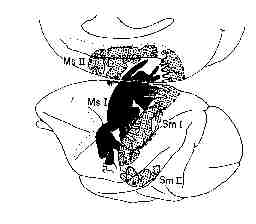
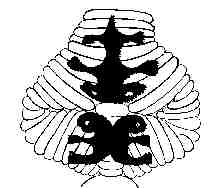
Mapping is a "bread and butter" function of the CNS. (Without it there would be no coherence. Indeed without it there could be no nervous system.) It is instructive (because it is a little simpler) to consider the mapping of the visual field. In the cat (and other mammals) the retina contains first, second and third order neurons. The third order "ganglion cells" project through the optic nerve to fourth order neurons in the lateral geniculate body where the visual field is mapped (in a rather complex manner on three folded "leaves"). These fourth order neurons in turn project to fifth and sixth order neurons in the visual cortex, area 17, and this map flips over to project another visual field map in area 18. It is intuitively compelling to imaging that these maps are arranged as "fields" - that the pixels, the neurons, don't have unique "discontinuous" addresses, but that they are labelled by degree of "leftness" and "rightness", "upness" and "downness"; that it is continuous dimensions or parameters that are labelled - much like on a television screen. So for the visual fields we might imagine that each neuron and its projections is labelled, first, for whether it comes from the left side or the right side of the body (this parameter, however, being a discrete rather than a continuous parameter) and then in terms of the degree of superior versus inferiorness (up/down) and nasal versus temporality (medial/lateral position), and that using the information from this (or similar) system of coordinates nerve processes from the retina find their appropriate place in the neural map. When we are thinking of the body map rather than the visual - of a three dimensional rather than a two dimensional system - again we may imagine that the left side versus the right side of the body is labelled discretely. Then there may be parameters for degree of lateral/medialness, cephalicness/caudality (head/toe or superior/inferior ), and ventral/dorsalness (front/back). But... (in order to avoid confusion) might not the subpart also be discretely labelled? Might not the hand, the left hand, be labelled not only (left and) so much a degree lateral, so much a degree posterior, but also HAND. In subparts where there is a lot of detail, such as the hands, feet, ears, a single field of encryption might not be sufficient to allow neurons to sort themselves out coherently. Fingers might get confused, blurred. There might be a need for overlap, for "redundancy", here. Now embryologically these detailed subparts do have there own special labelling. The eyes, nose, ears arise from "placodes" and the limb buds arise in a similarly discrete manner. I'm inclined to think that there must be such a double system of labelling for the hands, feet, ears, etc. Let's imagine that there were... if there were, there are some interesting implications. If there is this double encryption, if sites on the hand are labelled "HAND" as well as with local special coordinates (degree of laterality/mediality, distalness/proximity. dorsality/ventralness)... then, embryologically, when central connections are being made, a sensory nerve with peripheral location in the palm might look to connect in the sensory cortex with neurons in the "HAND" area with appropriate spacial coordinates (xyz degree medial, distal, ventral) - but it might also send some collateral dendritic attachments to neurons in the whole body map with those spacial coordinates (or possibly to a "TORSO" location with xyz degrees of medial, distal, ventralness). Likewise, when sensory
fibres from the abdomen are seeking central cortical connections they might primarily
project to a "TORSO" area with spacial coordinates xyz, but also send collaterals
to "HAND" xyz, and "FOOT" xyz and "EAR"xy(z). These would create faint (or ghost)
maps of the TORSO on the HAND. Note, that such a mechanism
of "ghost" connections (contingent on "double encryption") might explain the "reflex"
maps, but it does not in itself explain why reflexology (or auricular acupuncture)
is therapeutic as well as diagnostic. Why therapeutic though? Well in reflexology we don't just touch the ghosts. We work the ghost and somehow this information travels to the original visceral enlage. That's no explanation, but... possibly a fumbling in the direction of an explanation.
Science has two aspects... empiricism (fact and phenomena) and rationalism (thought and logic). We were taught in Europe (in the middle of the twentieth century) that the Scientific Method is rooted in empiricism. In America (at the end of the century) medical "experts" and scientists seem to mired in rationalism. If a phenomenon (like homeopathy, for example, or the Comaurosian effect) can't at this time be explained rationally then these so called, self-styled "scientists" dismiss the phenomenon. Indeed they sometimes denigrate those involved in alternative medicine as "empiricists". But it is rationalism, not empiricism that leads to fancy. One of the best examples of the dangers and limits or rationalism relates to the history of the auricular somatotopic map. Rudolf Steiner, the founder of the Waldorf School movement, spun a vast rational system he called "anthroposophy". Steiner intuited that the body was mapped on the ear, but where Nogier derived his auricular map from empiricism, Steiner derived his from his rational system. Steiner said the head was mapped at the top of the ear, the chest in the middle and the abdomen at the bottom. Steiner got it upside down! Rationalism is a useful and necessary exercise, but it is in danger of getting things backwards, if it stays near the truth at all.
But what of our speculations above about reflexological maps arising from double
encryption of somatotopic maps? that is an attempt at rationalism. Is there any
empirical data? Well, there is, though I'm not sure how directly it relates to
this phenomenon. |
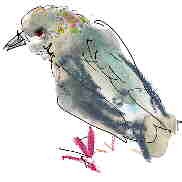 |